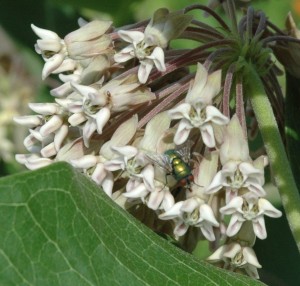June 30, 2015. This is a blowfly on my milkweed plant in front of my house. Culturally, we associate milkweed with the regal Monarch butterfly, whose story fascinates us: the beautiful orange butterfly makes a heroic journey every fall, travelling thousands of miles over mountains and plains to spend the winter in forests in the highlands of Mexico or in Southern California. Because it is so charismatic, the Monarch has many human fans—there are Monarch gardens, Monarch preservation societies—Monarchs have even been bred on the International Space Station! In fact, the reason I have milkweed in my yard is because of the sad decline of Monarchs, due in part to the decline of this plant, their larvae’s major food source.
But Monarchs aren’t the only pollinators of milkweed. The humble blowfly, more famous for its disgusting association with corpses than for its life cycle or its looks (though it is a cool metallic green), also visits the plant. The blowfly has few fans and nobody wants to preserve it—actually it is usually considered a pest. But in truth, the blowfly has an important role in flower pollination. Flies precede bees in evolution: along with beetles, they were the original pollinators of the first plants. Today they continue to visit flowers for their nectar and in so doing carry pollen from bloom to bloom. They prefer flowers that are dull and dark brown to purple in color—I suppose because these look more like rotten flesh than more colorful flowers. And these darker flowers like skunk cabbage and red trillium have even evolved putrid odors to attract flies.
This milkweed in my yard smells delicious, not corpse-like, but it is sort of dull and purple, so it makes sense that a blowfly is busily probing its blossoms. Researching the question “why a blowfly?” has made me re-evalute my anti-fly prejudices (somewhat). And it is another fascinating example of the complex interrelationships that weave the fabric of our common world. – Jim

